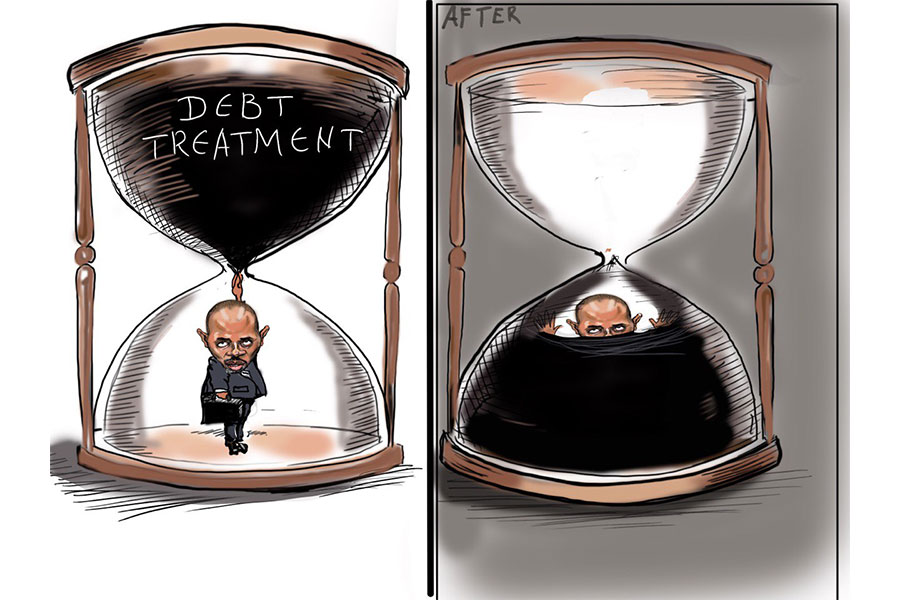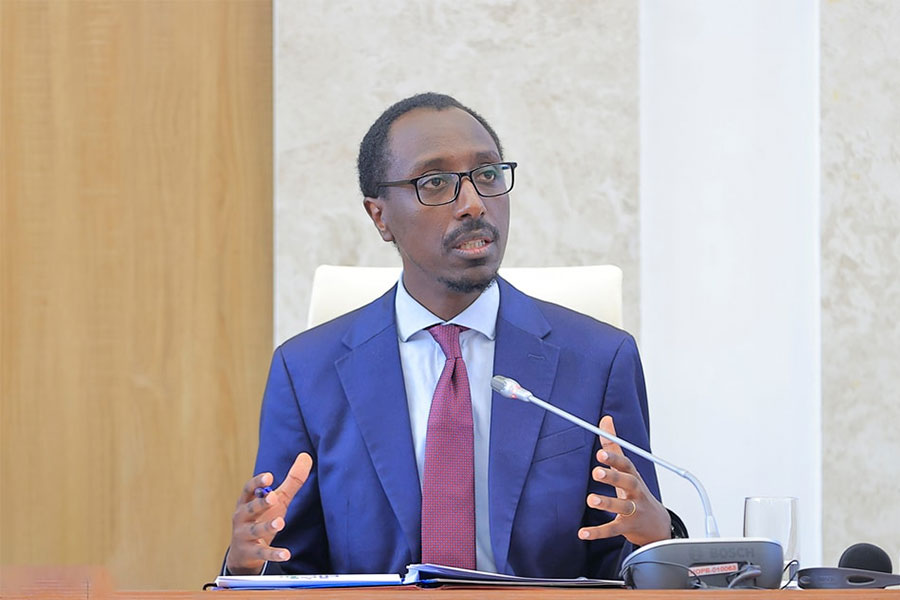
Fortune News | Feb 03,2024
Apr 15 , 2023
By Lars P. Feld,
High inflation today is a macroeconomic phenomenon resulting from too much money chasing too few goods and services. Worse, there are many reasons to worry that it will prove to be more persistent than many market participants have acknowledged, argues Lars P. Feld, a chair for economic policy and constitutional economics at Albert-Ludwigs-University of Freiburg. Project Syndicate (PS) provided this commentary.
Inflation is back, and it is demonstrating its usual tenacity.
In the United States, the inflation rate rose from 1.2pc in 2020 to 4.7pc in 2021 and 8.1pc in 2022. The forecast for 2023 is 3.5pc, but recent figures have shown a disappointingly modest decline. As of February 2023, the US annual inflation rate was six percent, but core inflation (excluding volatile energy and food prices) had increased by 0.5pc and remained high, at 5.5pc.
Inflation in the eurozone is demonstrating similar persistence. The annual rate increased from 0.3pc in 2020 to 2.6pc in 2021 and 8.4pc in 2022. And while inflation is expected to decline to 5.6pc in 2023, recent figures, like in the US, have been disappointing. In February, annual inflation decreased only slightly to 8.5pc (from 8.6pc in January), while core inflation increased to 5.6pc (from 5.3pc in January).
Far from being confined to the US and Europe, high inflation is a global phenomenon, with countries like Turkey and Argentina reporting record-breaking rates above 70pc. Indeed, only China and Japan have managed to maintain price stability among large economies. It is a pattern that raises anew old questions.
What causes inflation, and what should policymakers do to prevent it from becoming endemic?
It has become standard to look at different price components to identify what contributes most to headline inflation. Obviously, energy prices come to mind, and some observers have deemed today’s price rises “Putin’s inflation,” owing to the undeniable role that Russia’s invasion of Ukraine played in driving up firms' and households’ energy costs last year. This interpretation has encouraged the hope that inflation will be much lower in 2023, since energy prices are expected not to rise further this year, and perhaps even to decline.
Accordingly, some commentators in the US and Europe warn that monetary-policy tightening by the US Federal Reserve and the European Central Bank risks overshooting.
Such warnings are premature, if not counterproductive.
Inflation tends to become persistent because of second-round effects. Not only have producer prices risen much more during this period, but they also have not yet been fully passed through the value chain. Moreover, nominal wages have already increased or will do so this year.
For example, 2023 wage increases agreed between trade unions and employer organizations in the eurozone already amount to five percent, according to the European Central Bank (ECB). Since firms will try to pass these costs to their customers, core inflation will probably remain higher than professional forecasts currently suggest. More importantly, focusing on the relative strength of price components (like energy prices) as a causal factor overstates the microeconomic foundation of macroeconomics.
Inflation still is what it always has been: a macroeconomic phenomenon that results from the disequilibrium of aggregate demand and aggregate supply. As such, it is influenced by monetary and fiscal policy.
To illustrate this point, recall where we were in 2021. At 4.7pc, the inflation rate in the US was already high; and in the eurozone, it had started to accelerate by the year's second half. Energy prices in the eurozone rose considerably and contributed heavily to inflation before Russia invaded Ukraine. After the invasion, US markets were not particularly affected by the war’s price effects, but inflation continued to rise.
How, then, did this inflation come about?
In 2020-21, fiscal and monetary policy became highly expansionary as policymakers rushed to dampen the economic effects of the pandemic and stabilize the economy. This happened globally, but it was particularly pronounced in the US, where the fiscal stimulus mobilized by the Trump and Biden administrations was larger than the pandemic-driven decline in GDP. Moreover, US fiscal-policy expansion was accommodated by expansionary monetary policy, as the Fed stepped in to support aggregate demand.
Making matters worse, aggregate supply fell at the same time, owing to disruptions in transportation, value chains, and the labour market. Because the US economy is uniquely able to affect prices in international markets, its own bout of inflation spilled over to other countries, not least smaller economies within the European Monetary Union (EMU).
The fiscal- and monetary-policy mix was similar in Europe. The ECB purchased government bonds through its existing Public Sector Purchase Program and its new Pandemic Emergency Purchase Program (PEPP). With tax revenue down (owing to the COVID-19 crisis) and government spending up to support large stimulus programs, the ECB thus refinanced member states’ sharply higher budget deficits in secondary markets.
Monetary financing of fiscal policy became effective in the real economy through higher transfer spending, public consumption, and public investment. Price pressures therefore increased.
After the 2008 financial crisis, Queen Elizabeth II famously asked why nobody saw it coming. One could ask the same thing about the new inflation.
In the US, monetary policymakers and many commentators argued that the inflation in 2021 was only temporary. In a prominent exchange with former US Secretary of the Treasury Lawrence Summers, Paul Krugman of the New York Times made this point again and again. In Europe, the leading figure in the debate was Philip Lane, the ECB chief economist who continued to describe inflation as a temporary phenomenon even into 2022.
Tax policies in Germany (the largest eurozone economy) tended to support this view.
The German government had cut the headline rate of the value-added tax from 19pc to 16pc for six months from July to December 2020, leading to higher inflation figures recorded in subsequent months. In its annual report of November 2020, the German Council of Economic Experts estimated that this policy would add one percentage point of inflation.
Germany had announced an increase in its energy levies as of January 2021, extending carbon pricing to buildings and traffic. According to the GCEE, that contributed up to another percentage point to the inflation rate. Together with the base effect on energy prices overall, these temporary policies were used to make the case that the resulting inflation would be temporary, too. And, of course, similar justifications were offered by “Team Temporary” in other countries. But there were also many voices warning against this interpretation, most prominently Summers, who, in the spring of 2021, criticised President Joe Biden’s fiscal stimulus for being far too large.
The situation reminded him of the 1960s, when policymakers overestimated the economy’s ability to cope with a highly expansionary fiscal policy, out of an eagerness to accommodate conflicting demands and social concerns. Inflation rose from two percent to six percent between 1966 and 1969, well before the economy was hit by the first oil-price shock.
The parallels should now be obvious. Today’s inflation had already emerged before the supply shock caused by the Western sanctions in response to Russia’s aggression.
Similarly, in a now-famous Christmas Lecture in December 2020, Hans-Werner Sinn of the University of Munich warned that the eurozone’s highly expansionary fiscal and monetary policy mix would lead to a future of higher inflation. Back then, his views were dismissed with a smile by all those fiscal-stimulus aficionados on social media (who are always and everywhere advocating higher government spending). Since his lecture, Sinn has since elaborated on his argument in his book "Die wundersame Geldvermehrung" (The Miraculous Multiplication of Money).
Sinn’s viewpoint is at its heart monetarist: he emphasizes that the monetary base (M0) in the eurozone has grown extremely rapidly in recent years, from 1.2 trillion euros in March 2014 to six trillion euros in September 2021. But he also highlights the sharp growth in gross public debt among EMU member states, from 73pc of GDP in 1998 to 97pc in 2020, with the lowest figure (66pc) recorded in 2007.
Since 2015, the ECB – or the euro system – has purchased government bonds in secondary markets, thus refinancing expansionary fiscal policy. More intriguingly, Sinn describes the transmission process exactly. When EMU member-state economies were hit by the COVID shock, aggregate supply and aggregate demand fell. The ECB and member-state governments then reacted with expansionary monetary and fiscal policies, thus keeping aggregate demand high. But the aggregate supply remained suppressed because of distortions in value chains, labour-market shortages, and other production issues.
With too much money chasing too few goods, prices duly rose. It turns out that the Sinn of 2020 was a visionary. Why did no one listen to him? In the preface to his book, he notes that his Christmas Lecture received 1.6 million views online between December 2020 and the summer of 2021. But even if his argument was heard, it did not stick because modern macroeconomists had come to believe that monetarist thinking was outdated.
Indeed, Sinn had been warning for years that the ECB’s monetary policy would end up producing higher inflation, but eurozone inflation remained low from 2015 to 2019.
There is an important distinction to be made here between fiscal and monetary policy.
During the earlier period of unconventional monetary policy, when the ECB was purchasing assets through the PSPP, the liquidity injections remained largely in the European banking sector, where they helped to consolidate banks’ balance sheets by allowing them to write off non-performing loans against profits from monetary-policy programs. By contrast, the pandemic-era PEPP refinanced member states’ expansionary fiscal policies more directly.
With this mechanism in operation, Sinn no longer needed arguments about the monetary overhang. With its emphasis on the impact of excessive public debt, Sinn’s book complements other recent works warning of a revival of inflation.
For example, in their 2020 book "The Great Demographic Reversal", Charles Goodhart of the London School of Economics and Manoj Pradhan of Talking Heads Macro argue that societal aging will slow economic growth, reduce household savings, and increase the fiscal burden, because smaller cohorts of younger people will be supporting a larger share of retirees. These forces will create inflationary pressures on their own. The reduction in globalization dynamics will only add to them by removing some of the structural elements that have kept prices subdued.
In 2013, another prophet who glimpsed the end of price moderation, Brigitte Granville of Queen Mary University of London, published "Remembering Inflation", which emphasized fiscal policy's role in inflation - historically. Examining the origins of inflation, she starts with Peter Bernholz’s 2003 analysis of 12 case studies in which the monetary financing of budget deficits led to very high inflation.
But Granville takes this analysis further by systematically highlighting the importance of intertemporal budget constraints on public finances. There is always a danger when public debt increases faster than the real rate of economic growth. To account for this fully, one must consider the credibility of monetary and fiscal policies and potential conflicts and complementarities between monetary and financial stability.
Granville’s conclusion is clear: “[M]onetary policy on its own can do nothing in the long term to bring order to the public finances and increase real income; but high public debt can seriously increase inflation expectations. In other words, . . . money is the droit du seigneur, but the seigneur should not put his hand in the till. No sleight of hand can prevent the loss of credibility, and from this flows great distress.”
Sinn, Goodhart, Pradhan, and Granville all emphasize the impact of excessive public debt on inflation. But John H. Cochrane of the Hoover Institution has now provided the most systematic and elaborate analysis of this phenomenon. His new book, "The Theory of The Price Level", is the fruit of many years of work and ultimately offers a new starting point for a critical debate on the topic.
As Cochrane explained in a fall 2022 article in the "Journal of Economic Perspectives", the fiscal theory of the price level (FTPL) states that “inflation adjusts so that the real value of government debt equals the present value of primary surpluses.” Government debt is an asset that retains its value only as long as it promises to buy goods and services in the future, which in turn depends on the government repaying its debt at maturity. The real question, then, is whether the government will generate enough surpluses in the future to repay its debt.
Debt today is worth only as much as the government can repay in the future, just as the value of equity shares today can be described by the expected discounted future dividends. The FTPL describes the real price level as a function of debt, future surpluses, and the respective discount rate. Consequently, it is not suggesting a fateful relationship between inflation and debt. Rather, it states that today’s real value of debt needs to be adapted if sufficient future primary surpluses become increasingly unlikely.
Inflation becomes equivalent to default. This reasoning opens new perspectives on many issues, from the role of expectations and fiscal sustainability to the importance of fiscal rules and monetary regimes. For example, it turns out that a lack of fiscal sustainability can be a decisive cause of inflation (if the debt is higher than the amount of repayment that people think the government will be willing and able to accomplish).
Finally, the FTPL also sheds new light on the role of government bonds as safe assets. Markus Brunnermeier of Princeton University and his co-authors address this issue in a recent paper, showing that the safe-asset function can add a bubble component to government debt if its market value exceeds its fundamental value. If such a bubble exists, public debt may be sustainable even in the absence of primary surpluses.
But if a government’s future ability or willingness to repay debt comes into question, the bubble will burst. Again, fiscal-policy credibility is crucial. There is a systematic link between fiscal policy, debt sustainability, and inflation.
There are several lessons to be learned (or relearned) from the return of inflation.
Inflation is a macroeconomic phenomenon. It is insufficient to look only at specific price components such as energy – let alone to take comfort in the expectation that energy prices will soon peak. High inflation today is the result of too much money chasing too few goods and services. As such, inflation may prove to be more persistent than many market participants have acknowledged.
The interrelationship between monetary policy, fiscal policy, and financial stability plays an important role in inflation, making debt sustainability and expectations crucial factors.
These lessons hold three overarching policy implications: monetary policy needs to become restrictive to cope with currently high inflation; fiscal policy should not conflict with monetary-policy tightening; and, fiscal policy must return to a more credible and sustainable footing.
Returning to a path toward achieving primary surpluses would create fiscal space and allow primary deficits to be deployed against future crises without losing credibility. Such a policy shift would entail some risk. Recent developments show that interactions between monetary and fiscal policy can affect financial stability.
While banks hold large amounts of government bonds as risk-free (safe) assets, they also engage in maturity transformation when they turn short-term deposits into longer-term loans. Government bonds lose market value when interest rates increase, inducing write-offs on banks’ balance sheets. Banks thus need reserves that are sufficiently large to buffer these losses. If they are not, there can be a run on the bank.
In such a situation, a central bank might be forced to provide bailouts or postpone further interest-rate hikes. Financial dominance of monetary policy, therefore, would contribute to the persistence of inflation. The warnings that too much monetary-policy tightening will “break something” do have a point. But the argument is ultimately counterproductive in the fight against inflation.
PUBLISHED ON
Apr 15,2023 [ VOL
24 , NO
1198]


Fortune News | Feb 03,2024

Radar | Dec 08,2024

Editorial | Jul 17,2022

Life Matters | Aug 25,2024

Fortune News | Sep 01,2024

Verbatim | Jun 07,2025

Radar | Oct 08,2022

My Opinion | Jul 27,2024

Radar | Jan 09,2024

Radar | Sep 14,2024

My Opinion | 132041 Views | Aug 14,2021

My Opinion | 128437 Views | Aug 21,2021

My Opinion | 126364 Views | Sep 10,2021

My Opinion | 123987 Views | Aug 07,2021





Dec 22 , 2024 . By TIZITA SHEWAFERAW
Charged with transforming colossal state-owned enterprises into modern and competitiv...

Aug 18 , 2024 . By AKSAH ITALO
Although predictable Yonas Zerihun's job in the ride-hailing service is not immune to...

Jul 28 , 2024 . By TIZITA SHEWAFERAW
Unhabitual, perhaps too many, Samuel Gebreyohannes, 38, used to occasionally enjoy a couple of beers at breakfast. However, he recently swit...

Jul 13 , 2024 . By AKSAH ITALO
Investors who rely on tractors, trucks, and field vehicles for commuting, transporting commodities, and f...

Jul 12 , 2025
Political leaders and their policy advisors often promise great leaps forward, yet th...

Jul 5 , 2025
Six years ago, Ethiopia was the darling of international liberal commentators. A year...

Jun 28 , 2025
Meseret Damtie, the assertive auditor general, has never been shy about naming names...

Jun 21 , 2025
A well-worn adage says, “Budget is not destiny, but it is direction.” Examining t...

Jul 13 , 2025 . By YITBAREK GETACHEW
The Addis Abeba City Revenue Bureau has introduced a new directive set to reshape how...

Jul 13 , 2025 . By BEZAWIT HULUAGER
Addis Abeba has approved a record 350 billion Br budget for the 2025/26 fiscal year,...

Jul 13 , 2025 . By RUTH BERHANU
The Addis Abeba Revenue Bureau has scrapped a value-added tax (VAT) on unprocessed ve...

Jul 13 , 2025 . By NAHOM AYELE
Federal lawmakers have finally brought closure to a protracted and contentious tax de...